
Sodalite is a tectosilicate mineral with the formula Na
8(Al
6Si
6O
24)Cl
2, with royal blue varieties widely used as an ornamental gemstone. Although massive sodalite samples are opaque, crystals are usually transparent to translucent. Sodalite is a member of the sodalite group with hauyne, nosean, lazurite and tugtupite.

Proustite is a sulfosalt mineral consisting of silver sulfarsenide, Ag3AsS3, known also as light red silver or ruby silver ore, and an important source of the metal. It is closely allied to the corresponding sulfantimonide, pyrargyrite, from which it was distinguished by the chemical analyses of Joseph L. Proust (1754–1826) in 1804, after whom the mineral received its name.
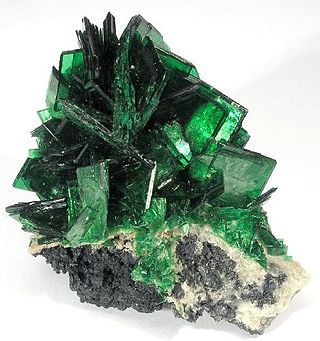
Torbernite, also known as chalcolite, is a relatively common mineral with the chemical formula Cu[(UO2)(PO4)]2(H2O)12. It is a radioactive, hydrated green copper uranyl phosphate, found in granites and other uranium-bearing deposits as a secondary mineral. The chemical formula of torbernite is similar to that of autunite in which a Cu2+ cation replaces a Ca2+ cation. Torbernite tends to dehydrate to metatorbernite with the sum formula Cu[(UO2)(PO4)]2(H2O)8.

Wurtzite is a zinc and iron sulfide mineral with the chemical formula (Zn,Fe)S, a less frequently encountered structural polymorph form of sphalerite. The iron content is variable up to eight percent. It is trimorphous with matraite and sphalerite.

Sulfosalt minerals are sulfide minerals with the general formula AmBnXp, where

Hutchinsonite is a sulfosalt mineral of thallium, arsenic and lead with formula (Tl,Pb)2As5S9. Hutchinsonite is a rare hydrothermal mineral.

Lorándite is a thallium arsenic sulfosalt with the chemical formula: TlAsS2. Though rare, it is the most common thallium-bearing mineral. Lorandite occurs in low-temperature hydrothermal associations and in gold and mercury ore deposits. Associated minerals include stibnite, realgar, orpiment, cinnabar, vrbaite, greigite, marcasite, pyrite, tetrahedrite, antimonian sphalerite, arsenic and barite.

Livingstonite is a mercury antimony sulfosalt mineral. It occurs in low-temperature hydrothermal veins associated with cinnabar, stibnite, sulfur and gypsum.
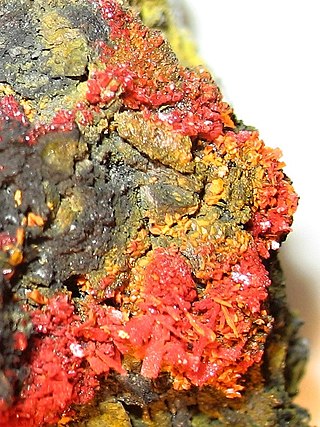
Alacránite (As8S9) is an arsenic sulfide mineral first discovered in the Uzon caldera, Kamchatka, Russia. It was named for its occurrence in the Alacrán silver/arsenic/antimony mine. Pampa Larga, Chile. It is generally more rare than realgar and orpiment. Its origin is hydrothermal. It occurs as subhedral to euhedral tabular orange to pale gray crystals that are transparent to translucent. It has a yellow-orange streak with a hardness of 1.5. It crystallizes in the monoclinic crystal system. It occurs with realgar and uzonite as flattened and prismatic grains up to 0.5 mm across.
The sulfarsenide minerals are a subgroup of the sulfide minerals which include arsenic replacing sulfur as an anion in the formula. Antimony and bismuth may occur with or in place of the arsenic as in ullmannite. The chemical formula of a sulfarsenide looks like a sulfosalt, however the structures are distinctly different. In sulfosalts the arsenic replaces a metal ion.

Bararite is a natural form of ammonium fluorosilicate (also known as hexafluorosilicate or fluosilicate). It has chemical formula (NH4)2SiF6 and trigonal crystal structure. This mineral was once classified as part of cryptohalite. Bararite is named after the place where it was first described, Barari, India. It is found at the fumaroles of volcanoes (Vesuvius, Italy), over burning coal seams (Barari, India), and in burning piles of anthracite (Pennsylvania, U.S.). It is a sublimation product that forms with cryptohalite, sal ammoniac, and native sulfur.
Barbertonite is a magnesium chromium carbonate mineral with formula of Mg6Cr2(OH)16CO3·4H2O. It is polymorphous with the mineral stichtite and, along with stichtite, is an alteration product of chromite in serpentinite. Barbertonite has a close association with stichtite, chromite, and antigorite (Taylor, 1973). Mills et al. (2011) presented evidence that barbertonite is a polytype of stichtite and should be discredited as a mineral species.

Getchellite is a rare sulfide of arsenic and antimony, AsSbS3, that was discovered by B. G. Weissberg of the New Zealand Department of Scientific and Industrial Research in 1963, and approved as a new species by the International Mineralogical Association in 1965. Many metal sulfides are grey to black, but a few are brightly colored. Orpiment is yellow to brownish gold, cinnabar is deep red and getchellite is a bright orange red.

Bismoclite is a bismuth oxohalide mineral with formula BiOCl. It is the naturally occurring form of bismuth oxychloride. The name was derived from its chemical constituents. It is a secondary bismuth mineral first thought to be composed of bismuthyl ions (BiO+) and chloride anions, however, the existence of the diatomic bismuthyl ion is doubtful.

Bismuth oxychloride is an inorganic compound of bismuth with the formula BiOCl. It is a lustrous white solid used since antiquity, notably in ancient Egypt. Light wave interference from its plate-like structure gives a pearly iridescent light reflectivity similar to nacre. It is also known as pearl white.
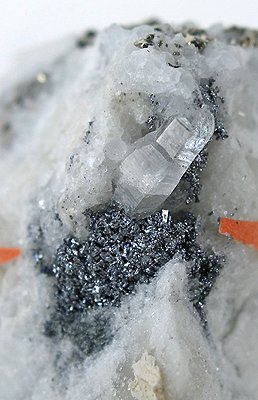
Marrite (mar'-ite) is a mineral with the chemical formula PbAgAsS3. It is the arsenic equivalent of freieslebenite (PbAgSbS3), but also displays close polyhedral characteristics with sicherite and diaphorite. Marrite was named in honor of geologist John Edward Marr (1857–1933) of Cambridge, England.

Pearceite is one of the four so-called "ruby silvers", pearceite Cu(Ag,Cu)6Ag9As2S11, pyrargyrite Ag3SbS3, proustite Ag3AsS3 and miargyrite AgSbS2. It was discovered in 1896 and named after Dr Richard Pearce (1837–1927), a Cornish–American chemist and metallurgist from Denver, Colorado.
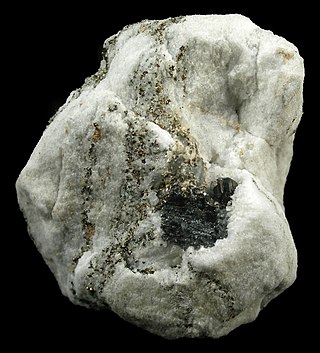
Sartorite is a lead arsenic sulfide with the chemical formula PbAs2S4 and as type locality the Lengenbach Quarry in Legenbach, Binnental, Valais, Switzerland. Historically, sartorite has been thought isomorphic to chalcostibite, emplectite, and zinckenite, but was definitively distinguished from the others in 1939.
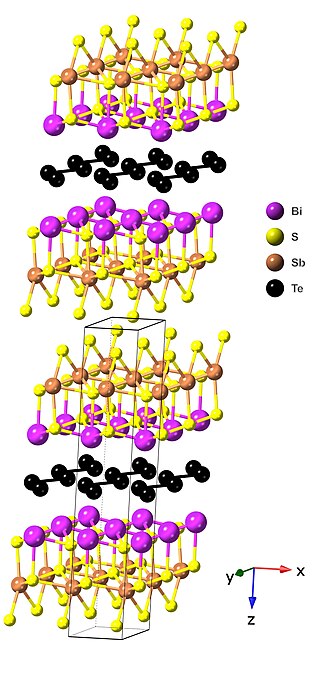
Kanatzidisite is a mineral of the sulfosalt class with a composition of [BiSbS3][Te2]. It crystallizes in the monoclinic crystal system (space group: P21/m) with lattice constants a = 4.0021(5) Å, b = 3.9963(5) Å, c = 21.1009(10) Å and β = 95.392(3)°. Its structure features very unusual van der Waals heterolayers of alternating BiSbS3 double layers and atomically thin distorted [Te2] square-net. Based on its calculated band structure, kanatzidisite may exhibit topological features characteristic of a Dirac semimetal. Associated minerals are arsenopyrite, pyrite, marcasite, sphalerite, chalcopyrite, gold, bismuth, bismuthinite, ikunolite, jonassonite, jaszczakite ([(Bi,Pb)3S3][AuS2]) and cosalite in a quartz matrix. A mineral specimen was detected by Luca Bindi and is currently stored in the Museum of Natural History of the University of Florence in Italy. The name of kanatzidisite is after Mercouri Kanatzidis, a distinguished chemist who holds the position of Professor of Chemistry at Northwestern University and Senior Scientist at Argonne National Laboratory.
Daliranite is a sulfosalt found in northwestern Iran with a general chemical formula of PbHgAs2S5. The mineral presents a vibrant orange-red color and fibrous habit which makes it resemble the oxide ludlockite being confused by its similarities in early studies. Named after Dr. Farahnaz Daliran, who has important contributions to research on ore deposits in Iran, this mineral was accepted by the International Mineralogical Association (IMA) in 2007.


















